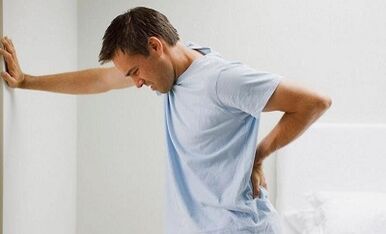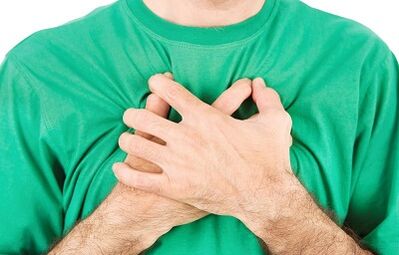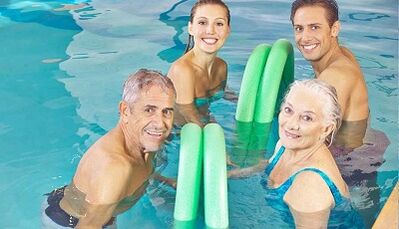
Lumbar osteochondrosis is chronic damage to the lumbar column that develops in intervertebral discs as a result of many years of physical influences and metabolic disorders.It is shown that lumbar osteochondrosis is the cause of back pain in 75% of cases.
The defeat of the lumbar column occurs in 60% of the inhabitants of the planet;This is the most frequent manifestation of osteochondrosis.The first signs of the disease appear at 20-30.
The danger of the disease is that in the posterior stages of the disease (when protuberance (protuberance) and the hernias of intervertebral discs) are produced, complications that require surgical intervention, in particular, plantar fascia and a stimulus are being developed.
Lumbar osteochondrosis often complicates pregnancy.
Causes of lumbar osteochondrosis
The main cause of the disease is the systematic load in the lumbar column and the metabolic disorders of the fibrous layer of the intervertebral discs.Lift weights, excess weight, constant physical work improves pressure on the vertebrate column.
Other causes of lumbar osteochondrosis: sedentary and sedentary lifestyle, constant use of high heels, malnutrition, consumption of small amounts of liquid, smoking, alcohol abuse.
When the protective muscle frame and the absence of treatment, the blood supply to the tissues worsens and the degenerative processes in the intervertebral discs worsen.As a result, intervertebral discs do not receive enough blood supply: they lose elasticity, "dry", inflamed, flattened and outstanding.
When protruding (protuberance), the spinal nerve spine is violated, which is manifested by resting pain and during the movements.Incorrect posture and lesions cause an additional unequal load in the spine, which accelerates the development of lumbar osteochondrosis.
Lumbar osteochondrosis stages
The peculiarity of the disease is the gradual development of degenerative processes.
Neurologists distinguish 4 stages of lumbar osteochondrosis:
- First stage& Mbsp;Partial inflammation and flattening disk.It is manifested by burning in the lower back and a stupid non -intense pain in the lower back.Unpleasant sensations arise after physical effort, weightlifting.
- Second stage- The distance between the vertebrae is reduced, the changes in the fibrous ring surrounding the tissues are determined in the radiography, and the protuberance of the discs occurs.The patient feels acute pain in the lower back, which gives (radiates) to the buttocks and legs.
- 3rd stage- The appearance of intervertebral hernias due to the destruction of the fibrous ring of the vertebrae.In the third stage, cartilage and vertebrae are intended intensely.Pain acquires constant character, they feel even at rest.
- Fourth stage- Atrophy of the cartilage and the intervertebral discs, accompanied by the pathological growth of the bone tissue of the vertebrae and the formation of osteophytes.Pain occurs with any awkward movement and body position.The pain does not go on its own.These violations require intensive treatment and lead to severe human disability.
Lumbar osteochondrosic symptoms

In seventy percent of cases, doctors diagnose the disease in the second stage.During this period, the patient indicates frequent periods of exacerbation with bright symptoms:
- Low pain, which is improved by physical effort.As the degenerative processes develop, pain becomes severe and constant;
- Movement restriction.The movements are accompanied by greater pain with irradiation in the buttocks and legs;
- change of sensitivity in the lower extremities (tingling, burning, numbness);
- spinal muscles voltage;
- Numbness and cold of the feet.
Diagnosis of Lumbar Osteochondrosis
In 85% of cases, doctors make a diagnosis using radiography, computerized tomography and magnetic resonance images (MRI).
The most directed method is MRI.With their help, doctors determine the place and degree of damage to the lumbar column.
The main task of the specialist is to distinguish the osteochondrosis of Bekhterev's disease.
Lumbar osteochondrosis complications
Lumbar radiculitis, or Roying syndrome: the pathological process in the infringed spinal nerve (column) is the most frequent complication of lumbar osteochondrosis.It occurs in 55% of cases.It is accompanied by pain and deteriorated sensitivity in the lower back and/or along the infringed root.
In the posterior stages of the disease, an intervertebral disk occurs on the edge of the vertebra: protuberance occurs.When the fibrous ring is destroyed, an intervertebral hernia is formed.Intervertebral hernia is an occasion to contact a neurosurgeon.
In 40% of patients, the sciatic nerve is inflamed.This causes pain, limb numbness.As a result, the patient tolerates body weight to a healthy leg;The spine is even more curved, which exacerbates the seriousness of the disease.

10% of patients develop a narrowing of the spinal channel, or compression myelopathy, pressing the spinal cord.It requires surgical treatment.
The most rare but dangerous complication is "horse tail" syndrome: the defeat of several nearby nerve roots.
Each third patient with this complication has paresis or leg paralysis.It also requires surgical treatment.
Lumbar osteochondrosis treatment
It is impossible to cure lumbar osteochondrosis.It can eliminate pain and reduce the speed of degenerative processes in vertebrae and discs.80% of the success in treatment falls into 1 and 2 stages of the disease.
If there are no complications, neurologists deal with the osteochondrosis of the lumbar department with medications, physiotherapy, massages and physiotherapy exercises.
Medications for osteochondrosis exacerbations are prescribed to eliminate inflammation, pain and stimulation of metabolism in vertebrae, cartilage, discs.
In acute pain, the therapeutic effect is achieved through intramuscular drug administration.For local anesthesia, the paravertebral block is prescribed.For 3-6 months, patients receive condoprotectors.
The purpose of physiotherapy exercises is to strengthen the posterior muscle of the back.Pool exercises are very useful.With lumbar osteochondrosis, the exercises are performed after eliminating pain.Some doctors recipe physiotherapy exercises even with pain, however, this must be approached with caution.
After pain decreases, massage and reflexology courses are recommended.
Uncomplicated lumbar osteochondrosis does not require treatment for frequent hospitalized patients and several days.The disease is treated at home.They resort to popular remedies whose action is reduced to heating the lower back.
Prevention of lumbar osteochondrosis
For the prevention of lumbar osteochondrosis, it adheres to simple rules:
- Follow the posture for many hours of stay in a sedentary pose, change the position of the body;
- swim 3 times a week;
- Lift gravity with two hands of a sitting position or, fixing (straightening) the back;
- Avoid drafts;
- For a rest night, choose an orthopedic mattress.


















